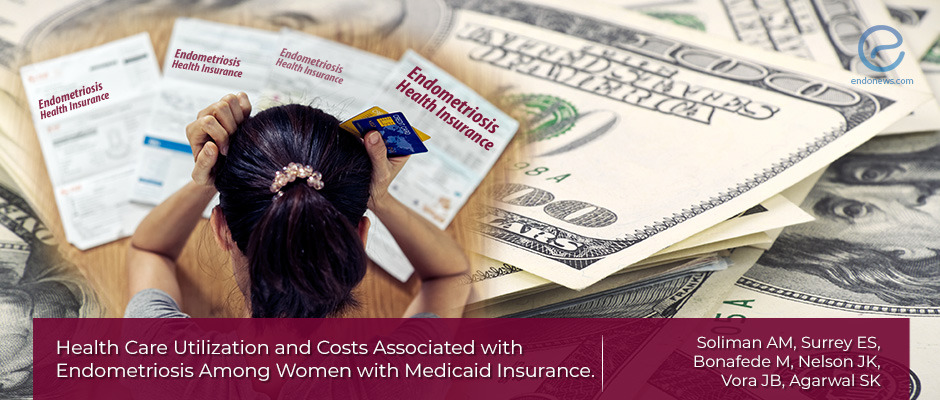Health care resource utilization and cost in women with endometriosis
Jul 11, 2019
Endometriosis is a chronic inflammatory disease that leads to higher health care utilization due to inpatient and outpatient medical costs.
Key Points
Highlights:
- Endometriosis poses a great economic burden on patients and the community due to late diagnosis and management.
Importance:
- Early diagnosis and proper management of endometriosis will reduce health expenditures.
What’s done here?
- Multi-State Medicaid Database was used to identify health care utilization in this retrospective cohort study.
- Women of reproductive age with newly diagnosed endometriosis for 6 years were included (n=15615).
- As a control group, age-matched women without endometriosis were selected from the same database (n=86829).
- The comparison was made between groups in terms of direct health care resource utilization (HCRU) and costs (medical or pharmacy) over the 12-month post-index period.
- The demographic and clinical characteristics of the patients (age, race, Medicaid eligibility, general health status) was measured; comorbid, gynecologic conditions, medication use was recorded.
- Hospitalization, emergency room visits, outpatient services, and prescriptions were assessed in the HCRU and expenditures.
Key results:
- Women with endometriosis had a higher rate of comorbid conditions including abdominal/pelvic pain, upper respiratory infections, depression, anxiety, hypertension, and migraine compared with controls.
- All types of medication use, especially opioid use, was significantly higher in the endometriosis group than in the control group.
- HCRU, hospital admissions, the rate of endometriosis-related surgery, emergency room visits, office visits during the 12-month post-index period were significantly higher in women with endometriosis compared to controls.
- The highest expenditure category in patients with endometriosis was inpatient admissions.
- Mean total health care costs were significantly higher in women with endometriosis compared with those without endometriosis.
Strengths and Limitations
- The strength of the study is to be the first study of the economic burden of endometriosis in the U.S. Medicaid population since 1995.
- Among several limitations, the limited available reports for the data analysis, probable classification errors, possible therapies such as over-the-counter pain and other medications, noncovered providers, or other self-management techniques not covered by Medicaid.
- The outcomes of this study reflecting the HCRU and costs in the U.S.A population cannot be generalizable to all women with endometriosis all over the world.
Lay Summary
Endometriosis is a chronic inflammatory disease affecting 6-10% of reproductive-aged women. The clinical picture of the disease range from asymptomatic findings to dysmenorrhea, dyspareunia, chronic pelvic pain, and infertility. Endometriosis has also complex etiopathogenetic background.
This broad clinical spectrum, the lack of understanding of the etiopathogenesis delay, make the diagnosis and treatment of the disease difficult. Despite extensive research, the optimal management of endometriosis still remains unclear. The decision for treatment should be patient-centered considering patient’s clinical presentation, age, the severity of symptoms, disease extent and location, reproductive desires, other comorbidities, side effects and complications related with medical treatment and surgery, and cost.
As a result, significant expenditures of time and health care resources have been used. Soliman et al, a group of scientists from the USA, published a study titled as “Health Care Utilization and Costs Associated with Endometriosis Among Women with Medicaid Insurance” in the journal named as "Journal of Managed Care & Specialty Pharmacy".
The authors sought to assess HCRU and costs in women with newly diagnosed endometriosis comparing with age-matched control women in the U.S. Medicaid population.
This is the first study evaluating endometriosis from economic aspects since 1995. Expenditure included hospitalization, emergency room visits, outpatient services, and prescriptions.
The authors found that mean total health care costs, all types of medication use, especially opioid use, HCRU, hospital admissions, the rate of endometriosis-related surgery, emergency room visits, office visits during the 12-month post-index period were significantly higher in endometriosis patients. Inpatient admissions account for the largest portion of expenditure for endometriosis.
Even if the results of the study can not be generalized to the whole world population, this study supports that early diagnosis and treatment will reduce the costs for endometriosis. Comorbid conditions such as abdominal/pelvic pain, upper respiratory infections, depression, anxiety, hypertension, and migraine were significantly more frequent in women with endometriosis than in the control group. These comorbid conditions contribute to health expenditure in women with endometriosis.
“These findings confirm previous studies of commercially insured patients and underscore the continued unmet need for early diagnosis and treatment of endometriosis,” they added.
Research Source: https://www.ncbi.nlm.nih.gov/pubmed/31039061
endometriosis health care resource utilization HCRU costs Medicaid insurance hospitalization emergency outpatient prescription hospitalization

